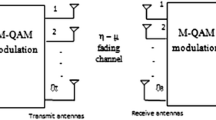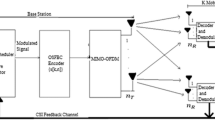Abstract
A variable-power (VP) adaptive modulation (AM) scheme with space-time block code (STBC) is developed in MIMO systems, and the corresponding performance is investigated in Nakagami fading channels. The optimum switching thresholds are derived so that the spectrum efficiency (SE) under an average power and a target bit error rate (BER) constraint is maximized. By the switching thresholds, average BER and SE are further derived. As a result, closed-form expressions are obtained. Besides, the exact and approximate BER expressions of VP AM and constant-power (CP) AM systems with delayed feedback are respectively derived. Simulation results show that the theoretical SE and BER can match the corresponding simulation well. The results indicate that VP-AM with STBC provide higher spectrum efficiency than the CP counterparts, and has slighter bite error rate performance degradation when the normalized delay is less than 0.01.
Similar content being viewed by others
References
Svensson A, øien G E, Alouini M S, et al. Special issue on adaptive modulation and transmission in wireless systems. Proc IEEE, 2007, 95: 2269–2273
Chae C B, Forenza A, Heath R W, et al. Adaptive MIMO transmission techniques for broadband wireless communication systems. IEEE Commun Mag, 2010, 48: 112–118
Goldsmith A J, Chua S G. Variable-rate variable-power MQAM for fading channels. IEEE Trans Commun, 1997, 45: 1218–1230
Maaref A, Aissa S. Capacity of space-time block codes in MIMO Rayleigh fading channel with adaptive transmission and estimation errors. IEEE Trans Wirel Commun, 2005, 4: 2568–2578
Alouini M S, Goldsmith A J. Adaptive modulation over Nakagami fading channels. Wirel Pers Commun, 2000, 13: 119–143
Maaref A, Aissa S. Rate-adaptive M-QAM in MIMO diversity systems using space-time block codes. In: Proc IEEE Int Symp Personal, Indoor Mobile Radio Commun., Barcelona, 2004. 2294–2298
Carrasco H M, Fonollosa R J, Delgado-Penin A J. Performance analysis of space-time block coding with adaptive modulation. In: Proc IEEE Int Symp Personal, Indoor Mobile Radio Commun., Barcelona, 2004. 493–497
Femenias G. Adaptive SR-ARQ combined with STBC in Markov channels. Electron Lett, 2004, 40: 377–378
Ko Y, Tepedelenlioglu C. Orthogonal space-time block coded rate-adaptive modulation with outdated feedback. IEEE Trans Wirel Commun, 2006, 5: 290–295
Yu X, Leung S H. Performance analysis of rate-adaptive modulation with imperfect estimation in space-time coded MIMO system. Wirel Pers Commun, 2011, 57: 181–195
Choi B, Hanzo L. Optimum mode-switching-assisted CP single- and multicarrier adaptive modulation. IEEE Trans Veh Technol, 2003, 52: 536–559
Gjendemsjø A, Øien G E, Holm H. Optimal power control for discrete-rate link adaptation schemes with capacityapproaching coding. In: Proc IEEE Global Telecommunication Conference. St. Louis, Missouri, 2005. 3498–3502
Zhou Z, Vucetic B, Dohler M, et al. MIMO systems with adaptive modulation. IEEE Trans Veh Technol, 2005, 54: 1828–1842
Yu X, Shi H. Performance analysis of variable-power adaptive modulation in space-time block coded MIMO diversity systems. Sci China Inf Sci. 2010, 53: 2106–2215
Shin H, Lee J H. Performance analysis of space-time block codes over keyhole Nakagami-m fading channels. IEEE Trans Veh Technol, 2004, 53: 351–362
Ahn K S, Heath R W, Baik H Ki. Shannon capacity and symbol error rate of space-time block codes in MIMO Rayleigh channels with channel estimation error. IEEE Trans Wirel Commun, 2008, 7: 324–33
Proakis J G. Digital Communications. 5th ed. New York: McGraw-Hill, 2007
Gradshteyn I S, Ryzhik I M. Table of Integrals, Series, and Products. 7th ed. San Diego, CA: Academic, 2007
Simon M K, Lindsey W C, Hinedi S M. Digital Communication Techniques Signal Design and Detection. Englewood Cliffs, NJ: Prentice-Hall, 1995
Hanzo L, Eebb W T, Keller T. Single- and multi-carrier quadrature amplitude modulation. New York: IEEE Press, Wiley, 2000
Nakagami M. The m-Distribution-A General Formula of Intensity Distribution of Rapid Fading, in Statistical Methods in Radio Wave Propagation. Oxford: Pergamon Press, 1960
Chiani M, Dardari D, Simon M K. New exponential bounds and approximations for the computation of error probability in fading channels. IEEE Trans Wirel Commun, 2003, 2: 840–845
Author information
Authors and Affiliations
Corresponding author
Rights and permissions
About this article
Cite this article
Yu, X., Chen, X., Bi, G. et al. Performance of orthogonal STBC-MIMO with variable-power adaptive modulation and delayed feedback in Nakagami fading channels. Sci. China Inf. Sci. 56, 1–10 (2013). https://doi.org/10.1007/s11432-012-4643-2
Received:
Accepted:
Published:
Issue Date:
DOI: https://doi.org/10.1007/s11432-012-4643-2




